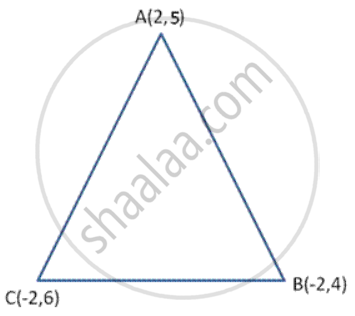Advertisements
Advertisements
प्रश्न
A(2, 5), B(-2, 4) and C(-2, 6) are the vertices of a triangle ABC. Prove that ABC is an isosceles triangle.
उत्तर

AB = `sqrt ((2 + 2)^2 + (5 - 4)^2) = sqrt (16 + 1) = sqrt 17` units
BC = `sqrt ((-2 + 2)^2 + (4 - 6)^2) = sqrt (0 + 4)` = 2 units
AC = `sqrt ((2 + 2)^2 + (5 - 6)^2) = sqrt (16 + 1) = sqrt 17` units
It can be seen that AB = AC
Hence , the given coordinates are the vertices of an isosceles triangle.
APPEARS IN
संबंधित प्रश्न
If A(5, 2), B(2, −2) and C(−2, t) are the vertices of a right angled triangle with ∠B = 90°, then find the value of t.
If the opposite vertices of a square are (1, – 1) and (3, 4), find the coordinates of the remaining angular points.
If the point P(x, y ) is equidistant from the points A(5, 1) and B (1, 5), prove that x = y.
Find the centre of the circle passing through (6, -6), (3, -7) and (3, 3)
Determine whether the points are collinear.
L(–2, 3), M(1, –3), N(5, 4)
The centre of a circle passing through P(8, 5) is (x+l , x-4). Find the coordinates of the centre if the diameter of the circle is 20 units.
Find distance CD where C(– 3a, a), D(a, – 2a)
Show that the point (0, 9) is equidistant from the points (– 4, 1) and (4, 1)
Find the value of a, if the distance between the points A(–3, –14) and B(a, –5) is 9 units.
The centre of a circle is (2a, a – 7). Find the values of a if the circle passes through the point (11, – 9) and has diameter `10sqrt(2)` units.
